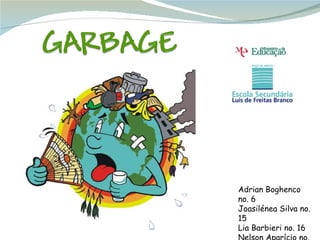Garbage work
•Download as PPT, PDF•
6 likes•2,850 views
Report
Share
Report
Share

Recommended
Concrete, Bituminous mixtures made with recycled concrete aggregates IDM8

Concrete, Bituminous mixtures made with recycled concrete aggregates IDM8Qatar University- Young Scientists Center (Al-Bairaq)
More Related Content
What's hot
What's hot (19)
NATIONAL SERVICE SCHEME, NATIONAL GREEN CORPS, CLIMATE EDUCATION AND WASTE MA...

NATIONAL SERVICE SCHEME, NATIONAL GREEN CORPS, CLIMATE EDUCATION AND WASTE MA...
Environmental Engineering (solid waste and its impact)

Environmental Engineering (solid waste and its impact)
Viewers also liked
Concrete, Bituminous mixtures made with recycled concrete aggregates IDM8

Concrete, Bituminous mixtures made with recycled concrete aggregates IDM8Qatar University- Young Scientists Center (Al-Bairaq)
Viewers also liked (20)
Green Remediation on a LEED Certified Brownfield Site

Green Remediation on a LEED Certified Brownfield Site
Concrete, Bituminous mixtures made with recycled concrete aggregates IDM8

Concrete, Bituminous mixtures made with recycled concrete aggregates IDM8
Energy from Waste Water Sewage Sludge in Lebanon - Ecorient 2013

Energy from Waste Water Sewage Sludge in Lebanon - Ecorient 2013
Presentation on Comparative study Of concrete using Recycled coarse aggregates

Presentation on Comparative study Of concrete using Recycled coarse aggregates
Experimental Study on Performance of Recycled Concrete Aggregate as Course Ag...

Experimental Study on Performance of Recycled Concrete Aggregate as Course Ag...
Similar to Garbage work
Zero Waste Management for Schools: A module prepared by Prof. Liwayway Memije...

Zero Waste Management for Schools: A module prepared by Prof. Liwayway Memije...Liwayway Memije-Cruz
Similar to Garbage work (20)
Graphic Organizer for Expository Essay Analysis.pptx

Graphic Organizer for Expository Essay Analysis.pptx
Zero Waste Management for Schools: A module prepared by Prof. Liwayway Memije...

Zero Waste Management for Schools: A module prepared by Prof. Liwayway Memije...
More from Clube do Ambiente
More from Clube do Ambiente (8)
Recently uploaded
Making communications land - Are they received and understood as intended? we...

Making communications land - Are they received and understood as intended? we...Association for Project Management
Recently uploaded (20)
Salient Features of India constitution especially power and functions

Salient Features of India constitution especially power and functions
Making communications land - Are they received and understood as intended? we...

Making communications land - Are they received and understood as intended? we...
Food safety_Challenges food safety laboratories_.pdf

Food safety_Challenges food safety laboratories_.pdf
Vishram Singh - Textbook of Anatomy Upper Limb and Thorax.. Volume 1 (1).pdf

Vishram Singh - Textbook of Anatomy Upper Limb and Thorax.. Volume 1 (1).pdf
Unit-V; Pricing (Pharma Marketing Management).pptx

Unit-V; Pricing (Pharma Marketing Management).pptx
Jual Obat Aborsi Hongkong ( Asli No.1 ) 085657271886 Obat Penggugur Kandungan...

Jual Obat Aborsi Hongkong ( Asli No.1 ) 085657271886 Obat Penggugur Kandungan...
On National Teacher Day, meet the 2024-25 Kenan Fellows

On National Teacher Day, meet the 2024-25 Kenan Fellows
Unit-IV; Professional Sales Representative (PSR).pptx

Unit-IV; Professional Sales Representative (PSR).pptx
ICT role in 21st century education and it's challenges.

ICT role in 21st century education and it's challenges.
Garbage work
- 1. Adrian Boghenco no. 6 Joasilénea Silva no. 15 Lia Barbieri no. 16 Nelson Aparício no. 20
- 4. Household waste Industrial waste Public waste Medical waste Nuclear waste Public waste Trash can be organized into different categories. In what refers to its chemical composition we have: - Organic residues and inorganic residues In what referes to his source we have the examples above.
- 6. Household Waste In this category are included leftovers, plastic, metal, glass, paper (packaging, cans, bottles, newspaper, magazines) etc. When improperly accumulated, organic waste can become highly polluters of soil, water and air. Besides that, the inadequate arrangement of waste creates an environment propitious to the development of pathogenic organisms.
- 11. Medical waste Is the classification given to dangerous residues produced in hospitals, like syringes, aprons, etc. By containing harmful agents this kind of garbage is separated from the rest of the residues produced in hospitals (leftovers, etc), and it is generally incinerated. However, certain hospital supplies, like aprons that were into contact with electromagnetic rays of high energy like X rays, are classified in a different way (the apron is considered nuclear waste) and have a different treatment.
- 12. One fish asks to another: What is that, acupunture? And the other answers: No, is medical waste thrown in the river
- 14. One of the consequences of throwing nuclear waste in the ocean is the increase of temperature. It disrupts the equilibrium of temperature in which live thousands of marine species.
- 16. Most of it remains in the open air, the remaining goes to landfills and incinerators. There is finally some remaining used for recycling.
- 26. This isn’t reusing, much less reducing !
- 29. Recycling does not hurt. It helps the environment !
- 37. The graphics on the left represent the estimated values of the group’s Ecological Footprint and the resources need to sustain our lifestyle compared to the average Portuguese citizen.
- 44. Conclusion After knowing where the things we throw away go, and what processes they suffer, it is possible to affirm that the elimination and treatment of our garbage is one of the most contributing factors for the pollution of the atmosphere, and sometimes (several times),water and soil pollution, when inadequately thrown away. Also after knowing a little bit more about the garbage workers, we think we need to be more respectful to them, once that they rend a dirty function, which the only goal is to serve society, cleaning her garbage and keeping it away from our door. Daily dealing with dirtiness and bad smells.